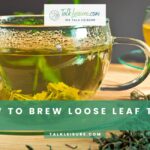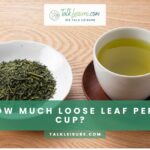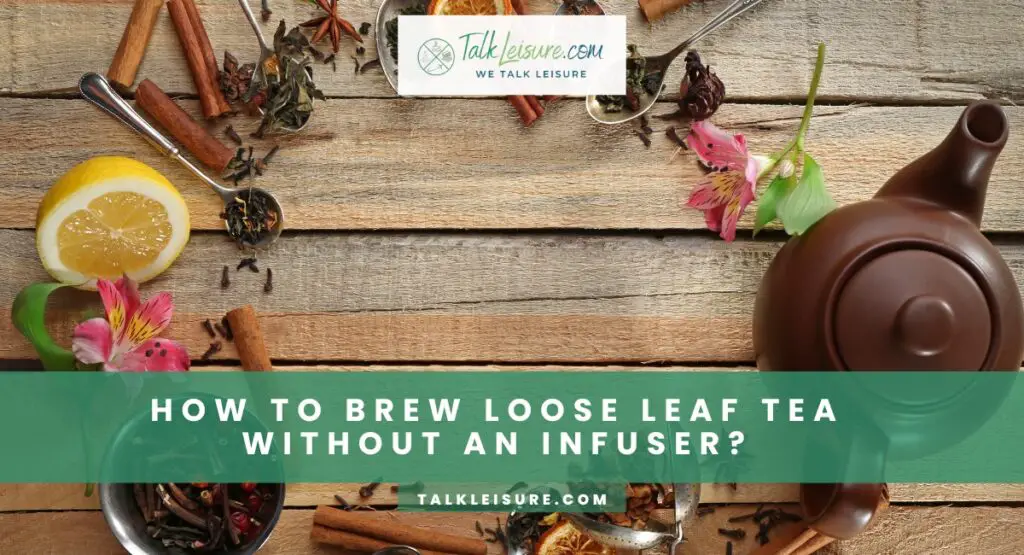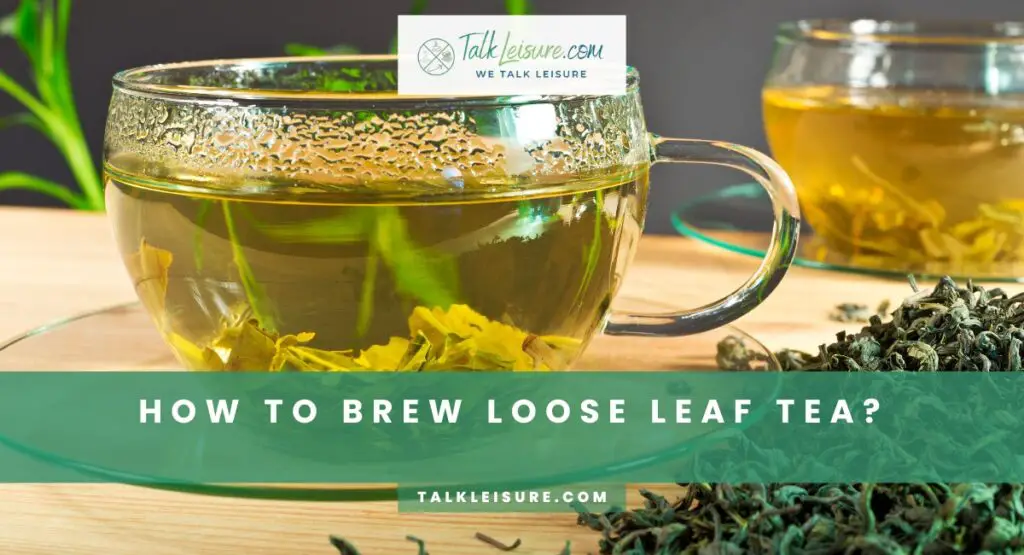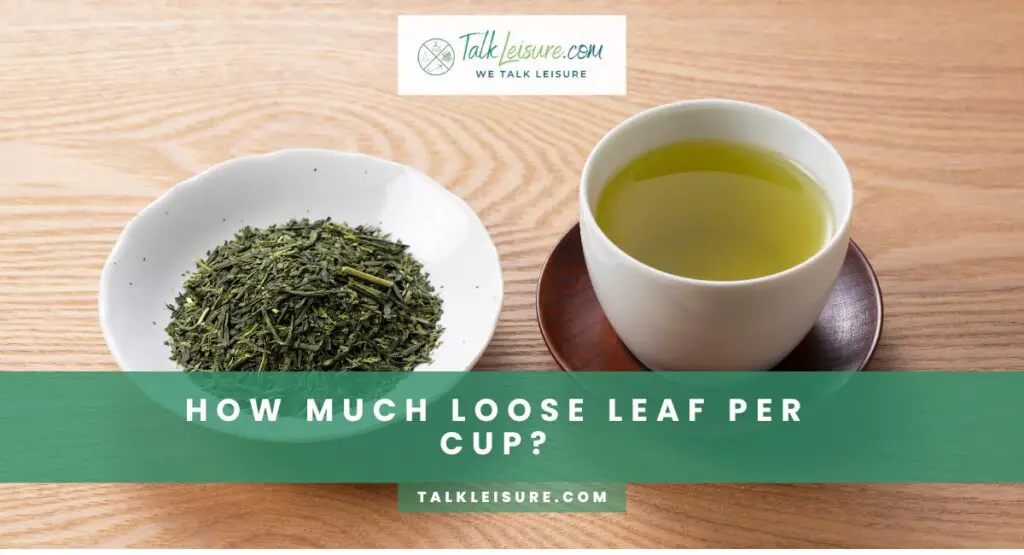Welcome to the delightful world of loose-leaf tea! If you want to savor the rich flavors and aromatic goodness of tea leaves, you’ve come to the right place.
Making loose-leaf tea is an art that promises a truly delightful and customizable experience, allowing you to brew your perfect cuppa every time.
In this article, we’ll take you through the step-by-step process of making loose-leaf tea like a pro, from selecting the finest leaves to mastering the art of steeping.
Get ready to embark on a journey of tea bliss that will elevate your tea-drinking ritual to new heights!
What Is Loose Leaf Tea?
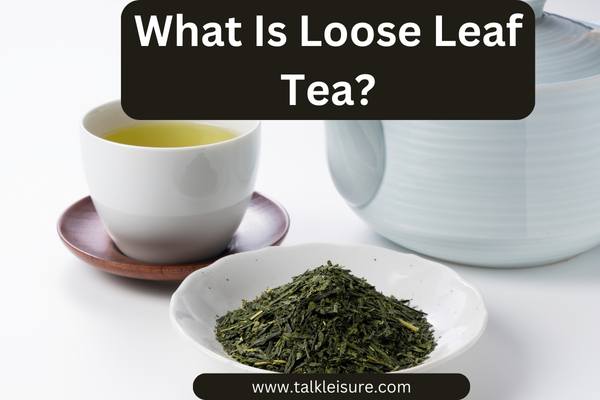
Loose-leaf tea refers to whole tea leaves not contained in tea bags.
It is a popular choice among tea enthusiasts due to its superior flavor and aroma compared to bagged teas.
Loose-leaf tea allows the leaves to fully expand and infuse in the water, resulting in a more robust and flavorful cup of tea.
It also offers a wider variety of tea options, including different grades and blends not typically available in tea bags.
How To Brew Loose Leaf Tea?

Brewing loose-leaf tea involves steeping the tea leaves in hot water for a certain period to extract the desired flavors and aromas.
The process may vary slightly depending on the type of tea and personal preferences, but the general steps are as follows:
- Start with high-quality loose-leaf tea. Look for fresh teas properly stored to ensure the best taste and aroma.
2. fresh, filtered water. The water temperature will vary depending on the tea you are brewing. Delicate teas like green and white teas require lower temperatures (around 170-185°F or 77-85°C), while black and herbal teas can withstand higher temperatures (around 200-212°F or 93-100°C).
3. Preheat your teapot or cup by rinsing it with hot water. This helps maintain the desired temperature for brewing and enhances the flavor of the tea.
4. Measure the loose-leaf tea. Use approximately one teaspoon of tea leaves per 8-ounce cup of water. Adjust the amount based on your taste preferences.
5. Add the tea leaves to a tea infuser or teapot. If using a tea infuser, place it directly in your cup or teapot. If using a teapot, pour the hot water over the tea leaves.
6. Steep the tea for the recommended time. Each type of tea has a specific steeping time that allows for the optimal extraction of flavors. Green and white teas typically require shorter steeping times (around 1-3 minutes), while black and herbal teas can be steeped for longer periods (3-5 minutes or more).
7. Taste the tea and adjust the steeping time if needed. You can taste the tea periodically during the steeping process to determine if it has reached your desired strength. Suppose it is too weak, steep for a bit longer. If it is too strong, reduce the steeping time in the future.
8. Remove the tea leaves or infuser Once the tea has steeped to your liking. If desired, you can dispose of the used tea leaves or reuse them for multiple infusions.
9. Enjoy your freshly brewed loose-leaf tea! You can drink it as is or add honey, milk, lemon, or other flavorings according to your preferences.
A Step By Step Guide To How To Make Loose Leaf Tea
- Boil fresh, filtered water.
2. Preheat your teapot or cup by rinsing it with hot water.
3. Measure approximately one teaspoon of loose-leaf tea for every 8-ounce cup of water.
4. Add the tea leaves to a tea infuser or teapot.
5. Pour the hot water over the tea leaves.
6. Steep the tea for the recommended time according to the tea type.
7. Taste the tea and adjust the steeping time if needed.
8. Remove the tea leaves or infuser from the teapot or cup.
9. Enjoy your freshly brewed loose-leaf tea as is or with added flavorings.
What Are The Different Ways To Make Loose Leaf Tea?

Several methods exist to make loose-leaf tea, depending on your preference and available equipment. Some common methods include:
Tea Infuser or Tea Ball: This is a popular method where loose tea leaves are placed inside a small metal, mesh ball, or infuser. The infuser is then placed in hot water to steep the tea.
Teapot with Built-in Strainer: Many teapots are designed with built-in strainers or filters that hold the tea leaves while allowing the water to pass through. This eliminates the need for a separate infuser or tea ball.
French Press: While commonly used for coffee, a French press can make loose-leaf tea. Simply add the tea leaves to the press, pour hot water over them, and allow them to steep. Press down the plunger slowly to separate the brewed tea from the leaves.
Teapot with Strainer Lid: Some teapots come with a built-in strainer in the lid. After steeping, the lid is used as a strainer to separate the tea leaves from the liquid as you pour.
Gaiwan: The Gaiwan is a traditional Chinese brewing vessel with a lid, a bowl-shaped cup, and a saucer. Loose-leaf tea is steeped directly in the Gaiwan, and the lid strains the tea as it is poured into small cups.
These are just a few examples of the different methods you can use to make loose-leaf tea. It’s worth exploring and experimenting with different methods to find the one that suits your taste and brewing preferences.
How To Make Tea With Tea Leaves And A Strainer?
Making tea with loose tea leaves and a strainer is a straightforward process. Here’s a step-by-step guide:
- Boil fresh, filtered water.
- Preheat your teapot or cup by rinsing it with hot water.
- Measure the desired amount of loose tea leaves. Use approximately one teaspoon of tea leaves per 8-ounce cup of water.
- Place the tea leaves in a tea strainer or fine mesh sieve.
- Place the strainer over your cup or teapot.
- Pour the hot water over the tea leaves, allowing it to flow through the strainer and into the cup or teapot.
- Steep the tea for the recommended time according to the tea type.
- Remove the strainer or sieve, allowing the brewed tea to remain in the cup or teapot.
- Enjoy your freshly brewed loose-leaf tea!
Using a strainer allows easy removal of the tea leaves while allowing the water to flow through and extract the flavors and aromas from the leaves.
How To Make Tea Leaves
The process of making loose-leaf tea starts long before it reaches your cup. Here is a general overview of how tea leaves are made:
Tea Plantation: The tea plant Camellia sinensis is cultivated on tea plantations. These plantations are typically located in regions with suitable climates and soil conditions for tea cultivation, such as China, India, Sri Lanka, Japan, and Kenya.
Plucking: Tea leaves are harvested by hand or machine. Hand plucking is the most common method for high-quality teas, where skilled workers selectively pick the young, tender leaves and buds.
Withering: The leaves are spread out on large trays or racks to wither after plucking. This process removes excess moisture from the leaves and prepares them for further processing.
Rolling: The withered leaves are rolled to break down the cellular structure and release the natural juices and essential oils. Rolling also helps shape the leaves into the desired form, such as twisted, curled, or rolled into balls.
Oxidation: Some tea varieties, such as black and oolong teas, undergo oxidation. The leaves are spread out and exposed to air, allowing enzymes to interact with the oxygen and cause the leaves to darken and develop their characteristic flavors.
Drying: The tea leaves are dried using various methods, such as pan-firing, sun-drying, or machine drying. This step stops the oxidation process, removes any remaining moisture, and preserves the flavor and aroma of the tea.
Sorting and Grading: Finally, the dried tea leaves are sorted and graded based on size, appearance, and quality. This ensures that each batch of tea meets the desired standards and specifications.
It’s important to note that the process can vary depending on the type of tea being produced.
Different types of tea, such as green, white, black, oolong, and herbal teas, go through slightly different processing methods to achieve their distinct flavors and characteristics.
How To Brew Tea
Brewing tea is a process that allows the flavors, aromas, and other beneficial compounds from the tea leaves to infuse into the water.
Here’s a step-by-step guide on how to brew tea properly:
- Boil fresh, filtered water. The water quality plays a significant role in the final taste of the tea, so it’s essential to use good-quality water.
- Preheat your teapot or cup by rinsing it with hot water. This helps maintain the desired temperature for brewing and enhances the flavor of the tea.
- Measure the appropriate amount of tea leaves for the desired strength. Generally, use approximately one teaspoon of loose-leaf tea leaves per 8-ounce cup of water. Adjust the amount based on your taste preferences.
- Place the tea leaves in a tea infuser, teapot or directly into your cup.
- Pour the hot water over the tea leaves, ensuring that all the leaves are submerged in the water.
- Steep the tea for the recommended time according to the type of tea you are brewing. Over steeping can taste bitter, while under steeping may produce a weak cup of tea. Follow the specific brewing instructions for the tea you are using.
- Once the tea has steeped to your liking, remove the tea leaves or infuser from the teapot or cup. Leaving the leaves in the water too long can make the tea taste bitter.
- Enjoy your freshly brewed tea as is or with added flavorings such as honey, milk, lemon, or sugar according to your taste preferences.
By following these steps, you can ensure that you brew a delicious and flavorful cup of tea with the desired strength and taste.
Steep Tea Meaning
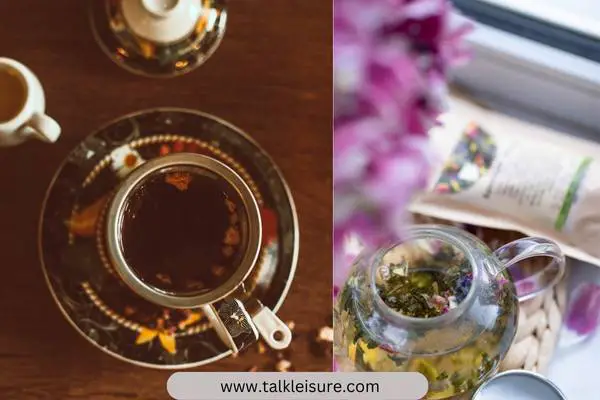
The term “steep” refers to infusing tea leaves or herbs in hot water to extract the desired flavors, aromas, and other beneficial compounds.
When the Tea leaves are steeped, they release their flavors and properties into the water, creating a delicious and aromatic cup of tea.
Steeping time refers to when the tea leaves are left in hot water.
Steeping time varies depending on the type of tea being brewed and the desired strength of the tea.
Steeping for too long can produce a bitter taste, while steeping for too short may not extract enough flavor from the leaves.
Following the recommended steeping time for the specific type of tea you are brewing is important to achieve the best results.
This ensures that you extract the optimal flavors and aromas from the tea leaves, resulting in a perfectly brewed cup of tea.
Beginner’s Guide To Loose Leaf Tea
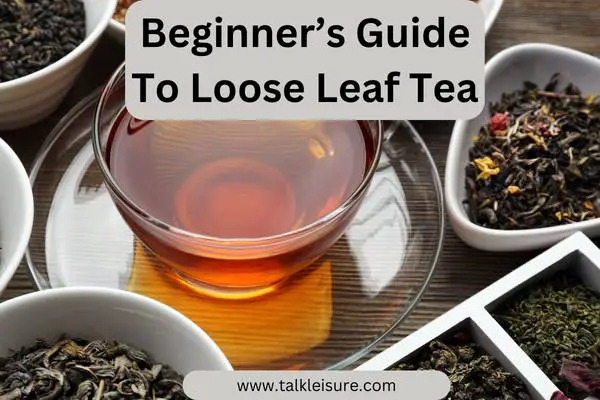
If you’re new to loose-leaf tea, here are some tips to help you get started:
Explore Different Tea Types: Loose-leaf tea offers various options, from green and black teas to herbal and oolong teas. Take the opportunity to try different tea types and discover your preferences.
Buy High-Quality Loose Leaf Tea: Find reputable sources offering high-quality loose-leaf tea. This ensures you get the best-tasting tea with optimal flavors and aromas.
Use Fresh, Filtered Water: The water quality for brewing tea can significantly impact the taste. Use fresh, filtered water to enhance the flavors of your tea. Avoid distilled or heavily chlorinated water, as they can affect the taste of the tea.
Pay Attention to Water Temperature: Different types of tea require different water temperatures for brewing. Delicate teas like green and white teas usually require lower temperatures (around 170-185°F or 77-85°C), while black and herbal teas can withstand higher temperatures (around 200-212°F or 93-100°C).
Use the Right Amount of Tea Leaves: The amount of tea leaves used will determine the strength and flavor of your tea. Generally, use approximately one teaspoon of loose-leaf tea leaves per 8-ounce cup of water. Adjust the amount based on your taste preferences.
Follow the Recommended Steeping Time: Each type of tea has a specific steeping time that allows for the optimal extraction of flavors. Follow the recommended steeping time provided with your tea for the best results. Over-steeping can taste bitter, while under-steeping may produce a weak cup of tea.
Invest in a Good Tea Infuser or Teapot: A good-quality tea infuser or teapot with a built-in strainer can make it easier to brew loose-leaf tea. Choose a size and style that suits your brewing needs and preferences.
Experiment with Flavors: Loose-leaf tea can be enjoyed as is or with added flavorings such as honey, milk, lemon, or sugar. Experiment with different flavor combinations to find your favorite way of enjoying tea.
Properly Store Your Tea: To maintain the freshness and flavors of your loose-leaf tea, store it in an airtight container away from heat, light, and moisture. Avoid storing it near strong odors, as tea can absorb odors easily.
Enjoy the Journey: Brewing and drinking loose-leaf tea is a sensory experience. Take the time to appreciate tea’s aromas, flavors, and moments of relaxation.
Remember, brewing loose-leaf tea is a personal process that can be tailored to suit your taste preferences. Don’t be afraid to experiment and adjust the brewing parameters to achieve your perfect cup of tea.
| Type of Loose Leaf Tea | Amount of Tea Leaf | Steeping Time Duration | Water Heat |
|---|---|---|---|
| Black Tea | One teaspoon | 3-5 minutes | 95°C (203°F) |
| Green Tea | One tablespoon | 2-3 minutes | 80°C (176°F) |
| White Tea | 1.5 teaspoons | 2-3 minutes | 80°C (176°F) |
| Oolong Tea | One tablespoon | 4-6 minutes | 90°C (194°F) |
| Herbal Tea | One tablespoon | 5-7 minutes | 100°C (212°F) |
| Rooibos Tea | 1 tablespoon | 5-7 minutes | 100°C (212°F) |
| Chamomile Tea | 1.5 teaspoons | 4-6 minutes | 90°C (194°F) |
Read more about loose-leaf tea for a better understanding.
How Much Loose Leaf Tea Per Cup?
The amount of loose-leaf tea needed per cup may vary depending on your taste preferences and the tea type used.
As a general guideline, you can start with approximately one teaspoon of loose-leaf tea per 8-ounce cup of water.
However, it’s important to note that some teas may require more or less tea leaves to achieve the desired strength and flavor.
For example, delicate teas like green and white usually require fewer tea leaves, while black teas may need slightly more.
It’s best to refer to the specific brewing instructions provided with your tea or adjust the number of tea leaves based on your taste preferences over time.
If you prefer a stronger cup of tea, you can slightly increase the tea leaves or steeping time.
On the other hand, if you prefer a milder cup of tea, you can reduce the amount of tea leaves or steeping time.
And brewing loose-leaf tea is a personal process, and you can adjust the amount of tea leaves to suit your taste.
How Long To Steep Loose Leaf Tea?
The steeping time for loose-leaf tea can vary depending on the type of tea being brewed and personal preferences.
Different teas require different steeping times to achieve the optimal flavor and aroma.
Here are some general guidelines for steeping different types of tea:
- Green Tea: 1-3 minutes
- White Tea: 1-3 minutes
- Oolong Tea: 3-5 minutes
- Black Tea: 3-5 minutes
- Herbal Tea: 5-7 minutes
These are general guidelines; the steeping time can be adjusted based on your taste preferences. You can steep it longer if you prefer a stronger cup of tea.
Conversely, you can decrease the steeping time if you prefer a milder cup of tea.
It’s important to note that steeping tea for too long can result in a bitter taste, especially for delicate teas like green and white teas.
Oversleeping can release tannins and other compounds that make the tea taste harsh. It’s best to start with the recommended steeping time and adjust it based on your taste preferences.
A Short Guide To What Are The Different Types of Loose Tea Leaves
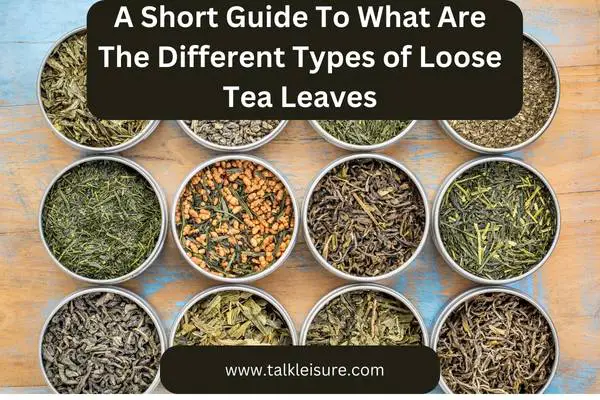
Loose tea leaves come in various types, each with unique characteristics and flavors. Here is a short guide to some common types of loose tea leaves:
Green Tea
Green tea is known for its delicate flavor, light color, and high antioxidant content. It undergoes minimal oxidation during processing, preserving its natural freshness and antioxidants. From Japanese Matcha to Chinese Dragonwell, green teas offer a range of flavors to suit different preferences.
Black Tea
Black tea is fully oxidized, resulting in a bold flavor, deep color, and robust aroma. It is often enjoyed with milk and sugar but also plain. Assam, Darjeeling, and Earl Grey are popular varieties of black tea.
Oolong Tea
Oolong tea is partially oxidized, producing a flavor profile between green and black teas. It offers various flavors, from floral and fruity to toasty and nutty. Oolong teas are known for their complexity and can be enjoyed plain or with sweetness.
White Tea
White tea is the least processed of all tea types, made from young tea leaves and buds. It has a delicate flavor, light color, and subtle sweetness. White teas offer a gentle and nuanced drinking experience.
Herbal Tea
Herbal teas, or tisanes, are untrue as they do not come from the tea plant. Instead, they are made from herbs, flowers, fruits, and spices. Herbal teas offer various flavors and can be enjoyed for their health benefits and soothing properties.
Rooibos Tea
Rooibos tea, also known as red tea, is made from the leaves of the Aspalathus linearis plant. It is naturally caffeine-free and has a mild, sweet flavor. Rooibos tea is a popular choice for those looking for a caffeine-free alternative.
Mate Tea
Mate tea is made from the leaves of the Yerba mate plant. It has a unique, robust flavor and contains natural caffeine. Mate tea is often enjoyed in South American countries and is known for its stimulating properties.
These are just a few examples of the different loose tea leaves available. Each type offers its distinct flavors, aromas, and health benefits. Exploring different tea varieties can be a delightful journey of discovering new flavors and expanding your tea palate.
How To Make Loose Leaf Tea Without An Infuser?
If you don’t have a tea infuser, there are still several ways to make loose-leaf tea without one. Here are a few alternative methods you can try:
Strain with a Fine Mesh Sieve: Place the loose tea leaves directly into a cup or teapot, and pour hot water over them. After steeping, pour the brewed tea through a fine-mesh sieve or strainer to catch the tea leaves.
Use a Tea Filter or Tea Bag: Fill a tea filter or empty tea bag with the desired amount of loose-leaf tea. Tie or seal the filter/bag to prevent the tea leaves from escaping. Steep the tea filter/bag in hot water like a tea infuser.
Use a Coffee Filter: Place the loose tea leaves in a coffee filter and tie it closed with string, or use a twist tie. Steep the tea filter in hot water as you would with a tea infuser.
Direct Steeping and Pour Out: You can place the leaves directly into the teapot or cup for larger tea leaves, such as herbal teas. After steeping, slowly pour the tea out, allowing the tea leaves to settle at the bottom or using a small strainer to hold back the leaves.
These methods can be convenient alternatives when you don’t have a tea infuser. They allow you to brew loose-leaf tea and enjoy its flavors and aromas with minimal equipment.
Can I Cold Brew Loose Leaf Tea?
Yes, you can cold brew loose-leaf tea! Cold brewing is a popular method for making iced tea and provides a refreshing and smooth taste. Here’s how you can easily cold brew loose-leaf tea:
- Add the desired amount of loose-leaf tea to a pitcher or glass container.
- Pour cold, filtered water over the tea leaves. The general ratio is approximately one tablespoon of loose-leaf tea per 8 ounces of water, but you can adjust the amount based on your taste preferences.
- Stir gently to ensure the tea leaves are fully immersed in the water.
- Cover the pitcher or container and place it in the refrigerator. Allow the tea to steep in the cold water for at least 6-8 hours or overnight for a stronger flavor.
- After steeping, strain or remove the tea leaves from the pitcher using a fine-mesh sieve or tea strainer.
- Serve the cold-brewed tea over ice, and enjoy! You can add sweeteners or flavorings such as lemon or mint if desired.
Cold brewing allows the tea leaves to infuse slowly in cold water, resulting in a milder and less bitter taste compared to hot brewing. It’s a simple and convenient way to prepare refreshing iced tea with the natural flavors of the tea leaves.
How To Drink Loose Leaf Tea?
Loose-leaf tea can be enjoyed in various ways. Here are a few popular ways to drink loose-leaf tea:
Plain: Many tea enthusiasts prefer plain loose-leaf tea without adding flavorings. This allows them to savor the unique flavors and characteristics of the tea itself.
With Honey: Adding honey to tea can enhance its sweetness and subtle flavor. It’s a popular choice for those who enjoy a touch of sweetness in their tea.
With Milk: Adding milk to tea is common practice in certain cultures, particularly with black teas. Milk can provide richness and creaminess to the tea and be enjoyed with or without a sweetener.
With Lemon or Citrus: Squeezing a fresh lemon or adding a slice of citrus to tea can provide a refreshing and tangy flavor profile, particularly with black or herbal teas.
With Herbs or Spices: Adding herbs or spices like mint, ginger, or cinnamon can create unique flavor combinations and add depth to the tea’s taste.
Blended with Other Teas: Mixing different types of loose-leaf teas can create custom blends with unique flavors and aromas. This allows for endless possibilities and a tailored tea-drinking experience.
Ultimately, choosing how to drink loose-leaf tea is a personal preference. Feel free to experiment with different flavorings and combinations to find your favorite way of enjoying loose-leaf tea.
Where To Buy Loose Leaf Tea?
Loose-leaf tea can be purchased from various sources, both online and in physical stores. Here are a few options for where to buy loose-leaf tea:
- Specialty Tea Shops: Specialty tea shops often offer a wide range of loose-leaf teas, including premium and rare varieties. They might also have knowledgeable staff who can provide guidance and recommendations based on your preferences.
- Online Retailers: Many online retailers specialize in selling loose-leaf tea. This allows you to explore vast teas from various regions and tea types. Online retailers often provide detailed descriptions and customer reviews to help you make an informed purchase.
- Farmers’ Markets: Farmers’ markets can be a great place to find locally sourced loose-leaf teas. Many tea vendors set up stalls at farmers’ markets, allowing you to sample and purchase their teas directly from the source.
- Tea Gardens and Estates: Some tea gardens and estates offer their teas for sale. Visiting these establishments can provide a unique opportunity to learn about tea-making and purchase teas grown and processed on-site.
- Asian Grocery Stores: Asian grocery stores often carry a variety of loose-leaf teas, especially those from China, Japan, India, and other tea-producing countries. It’s worth exploring the tea section of your local Asian grocery store for a diverse selection of teas.
When purchasing loose-leaf tea, consider factors such as the quality of the tea, the variety and origin of the tea, and the vendor’s reputation. Reading customer reviews and researching the company’s sourcing and production practices can also provide insights into the quality of the tea.
How To Store Loose Leaf Tea?

Properly storing loose-leaf tea is essential to maintain its freshness, flavors, and aromas. Here are some tips for storing loose-leaf tea:
Use an Airtight Container: Transfer loose-leaf tea to an airtight container, such as a glass jar or a sealed tin. Make sure the container is clean and dry before storing the tea.
Keep Away from Heat and Light: Store the tea container in a cool, dark place away from heat sources and direct sunlight. Heat and light can degrade the quality of tea and cause it to lose its flavors and aromas more quickly.
Avoid Moisture: Moisture can affect the quality of loose-leaf tea and lead to mold or spoilage. Ensure the tea container is kept in a dry environment, away from areas with high humidity, such as near the stove or sink.
Minimize Air Exposure: Exposure to air can cause the tea to become stale and lose its flavor. If the container has a good seal, this will help minimize air exposure. If using a larger container with excess air space, consider using smaller airtight bags within the container to limit contact with air.
Separate Flavored Teas: Flavored teas, particularly those with strong aromas like mint or citrus, can affect the flavors of other teas. Keep flavored teas separate from unflavored teas to prevent flavor transfer.
Avoid Strong Odors: Loose-leaf tea can easily absorb surrounding odors. Keep the tea container away from strong-smelling substances such as spices, coffee, or cleaning agents.
By following these storage tips, you can preserve the quality and freshness of your loose-leaf tea for an extended period, ensuring that each cup you brew is as delicious as the first.
The Five Best Method To Make Loose Leaf Tea?

While the best method to make loose-leaf tea may vary depending on personal preferences, here are five popular methods that tea enthusiasts often use:
Traditional Teapot Method: This method involves using a teapot to brew loose-leaf tea. It allows the leaves to expand and infuse, producing a robust flavor. Add the desired amount of tea leaves to the teapot, pour hot water over them, and steep for the recommended time before pouring them into cups.
Infuser or Tea Ball Method: This method involves using a tea infuser or tea ball. Place the tea leaves inside the infuser or ball, immerse it in hot water, and allow the tea to steep. Once the desired flavor is achieved, remove the infuser or ball from the water.
Gongfu Tea Method: This traditional Chinese tea brewing method involves multiple short infusions using a small teapot called a Gaiwan or a clay teapot. The process allows for nuanced flavors and a ceremonial experience. It is commonly used with oolong and pu-erh teas.
Western-Style Steeping: This method is similar to the traditional teapot method but often involves using a larger vessel with a built-in strainer or a larger tea infuser. It is commonly used for black, green, and herbal teas.
Brewing Method: This method involves steeping loose-leaf tea in cold water for several hours or overnight. The slow infusion process results in a smooth and refreshing iced tea.
These methods can be customized based on personal taste preferences, tea type, and desired strengths. Feel free to experiment and adjust the brewing parameters to find the method that produces your perfect cup of tea.
Customer Review On How To Make Loose Leaf Tea
According to the results online, Customers love loose-leaf tea! They praise its fresh, authentic flavor and a wide variety of options.
Many enjoy the rich aroma that fills their kitchen when steeping loose leaves.
The convenience of customizing their brew’s strength and experimenting with different infusions excites them.
Users often find loose-leaf tea a more sustainable choice, as it reduces waste compared to tea bags.
The high-quality leaves make it a top pick for tea enthusiasts seeking a delightful and satisfying tea-drinking experience. From calming chamomile to invigorating green teas, loose-leaf options cater to everyone’s tastes, with many benefits and enjoyable sipping moments.
These customer reviews highlight the joy and satisfaction of brewing and drinking loose-leaf tea. The versatility and rich flavors of loose-leaf teas make the process a truly rewarding experience.
Final Thoughts
Brewing loose-leaf tea is a delightful journey that allows you to explore various flavors, aromas, and traditions.
Whether you prefer a traditional teapot method, the convenience of tea infusers, or the artistry of gongfu tea brewing, loose-leaf tea offers endless possibilities for tea enthusiasts.
Remember to start with high-quality loose-leaf tea, use the appropriate water temperature and steeping time for each tea type, and adjust the brewing parameters to suit your taste preferences.
Store your loose-leaf tea properly to maintain its freshness and flavors for an extended period.
Embrace the art of brewing loose-leaf tea and savor each cup as you engage your senses and immerse yourself in the world of tea.
Explore different tea types, experiment with flavors, and enjoy the journey of discovering your favorite loose-leaf teas.
FAQ
What Is The Best Method For Making Loose Leaf Tea?
The best method for making loose-leaf tea is to use a tea infuser or teapot. Measure the desired amount of tea leaves, add hot water, and let it steep for the recommended time. Strain and enjoy.
How To Make 1 Cup Of Loose Leaf Tea?
Add one tablespoon of loose-leaf tea to a teapot or infuser. Pour 1 cup (8 oz) of hot water (175-185°F or 80-85°C) over the tea. Steep for 3-5 minutes, adjusting time to taste preference. Strain and enjoy your perfect cup of loose-leaf tea!
How Do You Make Loose Leaf Tea Without An Infuser?
Place loose-leaf tea in a heat-resistant vessel. Boil water separately and let it cool slightly. Pour the hot water over the tea leaves, filling the vessel. Steep for the desired time, usually 2-5 minutes. To strain, use a fine mesh sieve or pour through a coffee filter to remove the leaves. Enjoy your freshly brewed loose-leaf tea!
Best Wishes!




